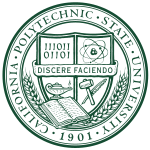California Polytechnic State University-San Luis Obispo
 |
|
| Motto | Discere Faciendo (Latin) |
|---|---|
|
Motto in English
|
To Learn by Doing |
| Type |
Public Space grant |
| Established | March 8, 1901 |
| Endowment | $190.3 million (2016) |
| President | Jeffrey Armstrong |
| Provost | Kathleen Enz Finken |
|
Academic staff
|
1,361 (Fall 2015) |
|
Administrative staff
|
1,654 (Fall 2015) |
| Students | 21,306 (Fall 2016) |
| Undergraduates | 20,425 (Fall 2016 |
| Postgraduates | 881 (Fall 2016) |
| Location | San Luis Obispo, California, U.S. |
| Campus | Suburban, 9,678 acres (3,917 ha) Total; 1,321 acres (535 ha) for the Main Campus; 155 acres (63 ha) for the Campus Core |
| Colors | Green and Gold |
| Athletics | NCAA Division I FCS – Big West |
| Nickname | Mustangs |
| Affiliations |
California State University AASCU APLU |
| Mascot | Musty the Mustang |
| Website | www |
| University rankings | |
|---|---|
| National | |
| Forbes | 153 |
| Regional | |
| U.S. News & World Report | 9 |
| Master's University class | |
| Washington Monthly | 40 |
California Polytechnic State University, or Cal Poly San Luis Obispo, is a public university located in San Luis Obispo, California. Founded in 1901, it is among a small group of public STEM universities in the United States. Cal Poly's curriculum has an extensive history in engineering, mathematics, agricultural and environmental science, architecture, and business and entrepreneurship.
The university is organized into six colleges offering 64 bachelor's and 32 master's degrees. Cal Poly primarily focuses on undergraduate education with 20,425 undergraduate and 881 graduate students.
Cal Poly is known for it's "learn by doing" philosophy that encourages students to combine research theory with experiential practice to solve real-world problems. This practical philosophy, as well as a technical scientific education, enables Cal Poly to rank in the nation's top colleges for student's return on investment. The university participates in the Big West Conference in athletics.
Cal Poly was established as the California Polytechnic School in 1901 when Governor Henry T. Gage signed the California Polytechnic School Bill after a campaign by journalist Myron Angel. The polytechnic school held its first classes on October 1, 1903 to 20 students, offering secondary level courses of study, which took three years to complete. The school continued to grow steadily, except during a period from the mid 1910s to the early 1920s when World War I led to drops in enrollment and drastic budget cuts forced fewer class offerings.
In 1924, Cal Poly was placed under the control of the California State Board of Education. In 1933, the Board of Education changed Cal Poly into a two-year technical and vocational school. The institution began to offer Bachelor of Arts degrees in 1940, with the first baccalaureate exercises held in 1942. The school was renamed the California State Polytechnic College in 1947 to better reflect its higher education offerings, and in 1949, a Master of Arts degree in education was added. In 1960, control of Cal Poly and all other state colleges was transferred from the State Board of Education to an independent Board of Trustees, which later became the California State University system.
...
Wikipedia
